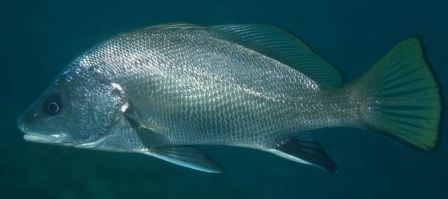Common silver croaker in marine fish farming

The common silver croaker is a promising fish for growing in fish farming. An important fish in fisheries and aquaculture in the Mediterranean.
Content
- Description common silver croaker
- What does a common silver croaker look like?
- Biology and habitat of the common silver croaker
- Breeding methods for silver croaker
- Silver croaker nursery
- Intensive breeding of croaker
Description common silver croaker
Common silver croaker, Latin name Argyrosomus regius (Asso, 1801), lives in the Eastern Atlantic, including the Mediterranean and the Black Sea. It is grown in the Mediterranean, but there are prerequisites for its cultivation in the Black Sea.
What does a common silver croaker look like?
The common silver croaker is characterized by a relatively large head, an elongated spindle-shaped body and small eyes. The lateral line is very pronounced, reaches the caudal fin and is equipped with 50-55 scales. The second dorsal fin is longer than the first. The swim bladder of the silver croaker contains branched appendages that allow this species to produce a characteristic rumbling sound. The body color is silvery-gray, darker on the back and with some bronze features on the sides. The abdomen is whitish, the base of the fins is reddish with a brown tint, the oral cavity has golden-yellow tones. The silver croaker in the adult phase can reach a maximum length of more than 2 m and a weight of more than 50 kg.
Biology and habitat of the common silver croaker
The silver croaker is found throughout the Mediterranean, but is quite rare off the coast of Italy and Greece. The largest specimens have been found along the coasts of West Africa, particularly in Dakar Bay in Senegal, where large croakers find refuge among the wrecks of sunken ships. Croaker grows especially well in the summer season, and in the cold season, when the water temperature drops to 13-15°C, it sharply reduces its feeding regime.
During the breeding season, around mid-April, spawners move closer to the coast and begin to penetrate river mouths in May. Females lay up to 800,000 eggs, and the optimal temperature for completion of spawning is between 17 and 22°C. During this period, males make a characteristic sound caused by the release of air from the swim bladder, caused by the pressure on it from the abdominal muscles.
Between mid-June and July, croaker spawners gradually return to the marine environment and settle near the coast, where they remain until autumn to feed. Later, with the arrival of the winter season, croakers return to the open sea.
By the end of summer, juvenile croakers leave the estuarine areas in which they were born and migrate towards the sea, settling in coastal waters. Small croakers spend the winter in these areas and return to the river mouths to feed from mid-May. Water temperature is a determining factor in the beginning of the reproductive season and the migration phases of both adult and juvenile forms.
The optimal temperature range for croaker growth is 17 to 21°C, but acceptable results have also been obtained at temperatures between 14 and 23°C.
Breeding methods for silver croaker
The silver croaker is one of the most recent species to be introduced into Mediterranean fish farming. The first breeding trials were carried out in France, and the specimens used were obtained from wild catches. Subsequently, in 1996, a French hatchery began breeding silver croaker in captivity, but production was still limited. Commercial production of silver croaker began a year later, in 1997, and croaker farming subsequently began to develop, albeit slowly, in neighboring countries.
Croakers are reared in intensive systems, both in land-based facilities and in sea cages, and the main production centers are located along the southern coast of France (Cannes, Camargue), Corsica and Italy (La Spezia, Orbetello).
Silver croaker nursery
As a rule, small croakers weighing from 3 to 20 g are placed in small tanks or cages with a volume of approximately 80-100 m3. The density adopted in these structures is 300-350 fish per m3, and the fish remain there until they reach a weight of 100 g.
Intensive breeding of croaker
As for the feeding phase, the methods used to catch croaker are very similar to those used to catch sea bass and sea bream.
In land-based farming, rectangular or round concrete tanks lined with a thin layer of PVC are usually used to avoid abrasions on the skin of the farmed fish.
These structures have a volume of about 500 m3 and the water level inside is 1 m. At a density of about 50 fish per m3, croaker can reach a weight of 800-1000 g in less than 24 months, but this species is usually bred until it reaches weight 2000-3000 g.
Most popular destination The solution is to breed croakers inside floating cages, both round and square, with a volume of 500 to 1000 m3. Recently, underwater structures located at a depth of 10-20 m3 have been used to breed this species. m, with a volume of 2000 m3 and a reduced planting density (10-15 individuals/m3). Excellent growth rates of croaker were found under these breeding conditions.